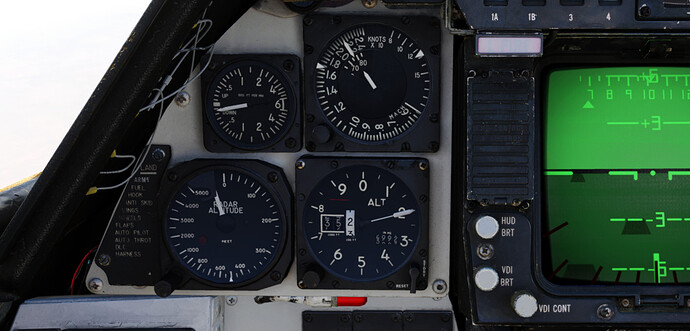Yeah…I don’t know anything about anything…but it seems like the Phoenix loses a lot of energy up there at the 60,000+ realm that it lofts to. I thought it was supposed to scream along at Mach 3 up there, but it seems to struggle up there in the sim. If I’m not mistaken the “ribbon” (external view info bar) gives TAS correct? Because I see 2300 knots during the tail end of the boost, but 500-600 knots at 60K. And based on watching it on the F10 map it does seem to be going slow. I dunno.
Well, circling back around to this. I went up, expended all of my missiles, then went into full afterburner (F-14A) and stuck around Mach 1.1 until I got to 45,000’ or so. Pushed over and let it accelerate to about Mach 1.3 in level flight…then started a couple thousand feet per minute shallow dive. By 35,000’ I was doing Mach 1.9, and in level flight continued to accelerate slowly up to Mach 2.15 before I ran out of gas. So perhaps it just a bit of technique (“getting on the step” was how it was often referred to in aviation…often viciously debated like the famed downwind turn…LOL…)…
So single engine carrier landings in the F-14A (or B even I’m sure) are pretty exciting. Even at a relatively low weight, that remaining engine is running at a pretty high power setting once you are dirtied up and in the groove. It isn’t hard to imagine how you can get slow and run out of rudder…particularly in the event of a go-around or bolter… Throw in poor weather, dark of night…

Your statement on that got me thinking last night…so resumed testing this morning (I need a test livery…LOL…). My initial test launch conditions were 25,000’ and Mach .9 or so…with a bunch of missiles and fuel tanks hanging off.
I changed the test conditions today to high altitude, going up to 45,000’, dropping fuel tanks, and accelerating to Mach 2.1 in a shallow descent to 35,000’. Was able to reach Mach 2.1 even with 6 AIM-54As loaded. (Was the -54C available for the F-14A?)
Launched at 110 miles…with the added “throw weight” of hauling along at Mach 2, the missile accelerated to 2900 knots and lofted to 88,000’ (compared to 2300 knots and 67,000’ from the Mach .9 / FL350 launch). The missile missed at 110 miles, the second and third missiles fired from 80 and 65 miles both hit.
Of course…pushing along at Mach 2+ eats up the gas…so your time of engagement in that realm is pretty limited, and if the AIM-54 doesn’t work, you end up in a fight with no gas…might be best to just blow past em at Mach 2… ![]()
If you like to maximized climb and speed profiles, you should try my anti-ship missile intercept quick missions. Get as high and fast as quickly as possible to shoot down incoming AS-4 Kitchen at 80’000 ft.
So color me stupid…but I’m sitting here looking at two different screenshots I’ve taken of the F-14A vs. F-14B cockpits…is there anything in the cockpits that are different? I thought maybe the engine tapes might be slightly different…but they look the same. What am I missing?
I had the same feeling @BeachAV8R I’ve not spent enough time in the A yet. But i couldn’t see anything immediately different
Nothing’s different. The behavior of the nozzle position gauges is different. Other than that, identical pits.
Does the -B also cruise at angels 25 at mach .85 with the engines throttled back almost to idle? I love how economic the kitty gets at that cruise setting. Would love to have that in MSFS2020 ![]()
Also…I thought the -A had a difference in the Direct Lift Control (DLC) where the -A had all four spoilers deploy during DLC whereas the -B is supposed to just have two. But in my testing, I only see the same behavior regardless of model…
F-14A
F-14B
Hot damn, those are really smokin’ burners right there.
According to the manual, there will be a third position on the Displays Control Panel switch for the “HSD Mode” at least for AN/ALR-45 equipped A models. I think the currently implemented F-14A-135-GR uses the more modern AN/ALR-67 so no difference yet.
Apart from that, there’s an A-specific Mid Compression Bypass Test panel (not sure if implemented yet) and some minor differences in the idiot lights.
Thought same. If I recall, HB is doing 3 -A versions and the one we have now is the latest - meaning it’s really close to the -B. Like, really close. Cept the motors of course.
Nevermind…I think I found my math error…
Oh…that explains it. The FF gauge does not read true afterburner fuel flow value…
Actually, the cockpit we have now has always been the A (late) cockpit. For the proper B pit, Heatblur still needs to replace the analog engine tapes with digital ones.
The regular A cockpit on the other hand will still require the removal of the RWR display (the old AN/ALR-45 had its output on the TID screen). The current A (late) cockpit with the AN/ALR-67 RWR display is a 2000-ish refit.
thats a mess! ![]() …my money still patiently waiting for my early A model
…my money still patiently waiting for my early A model






